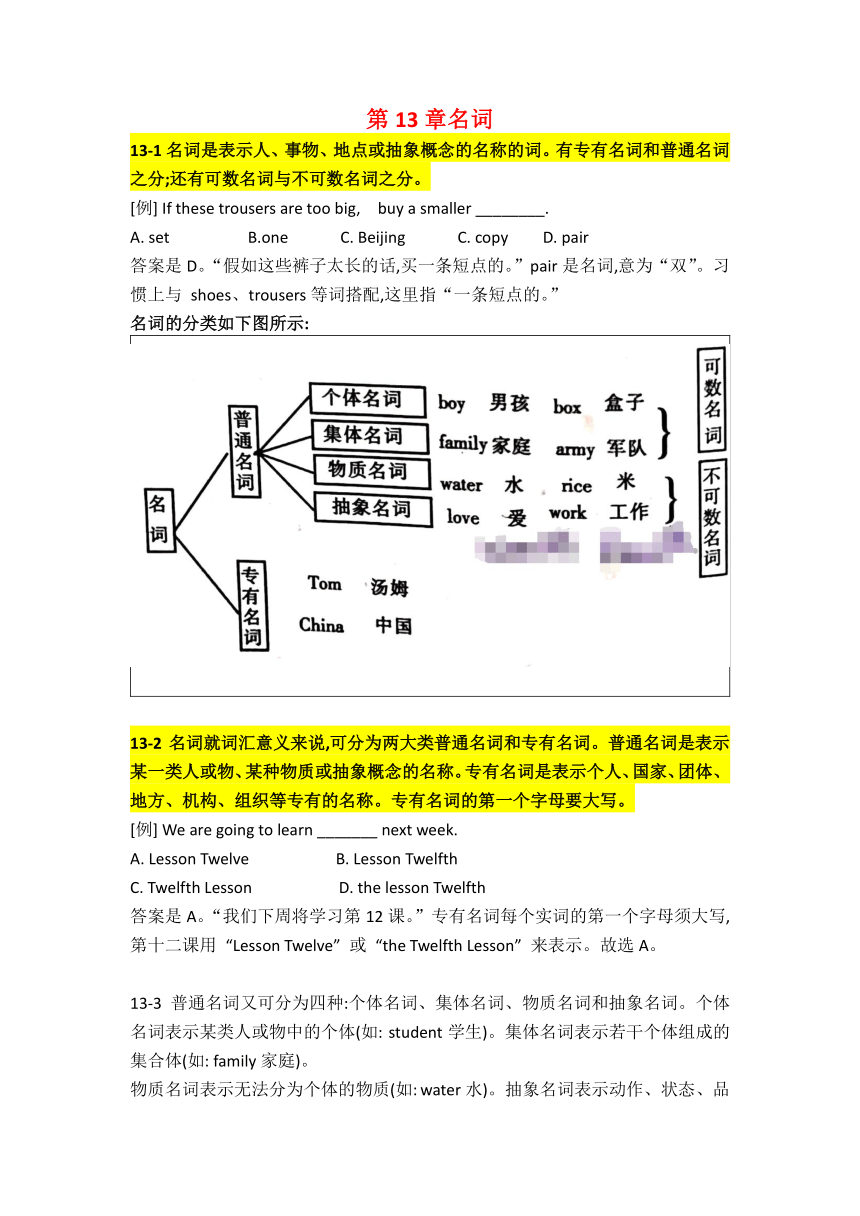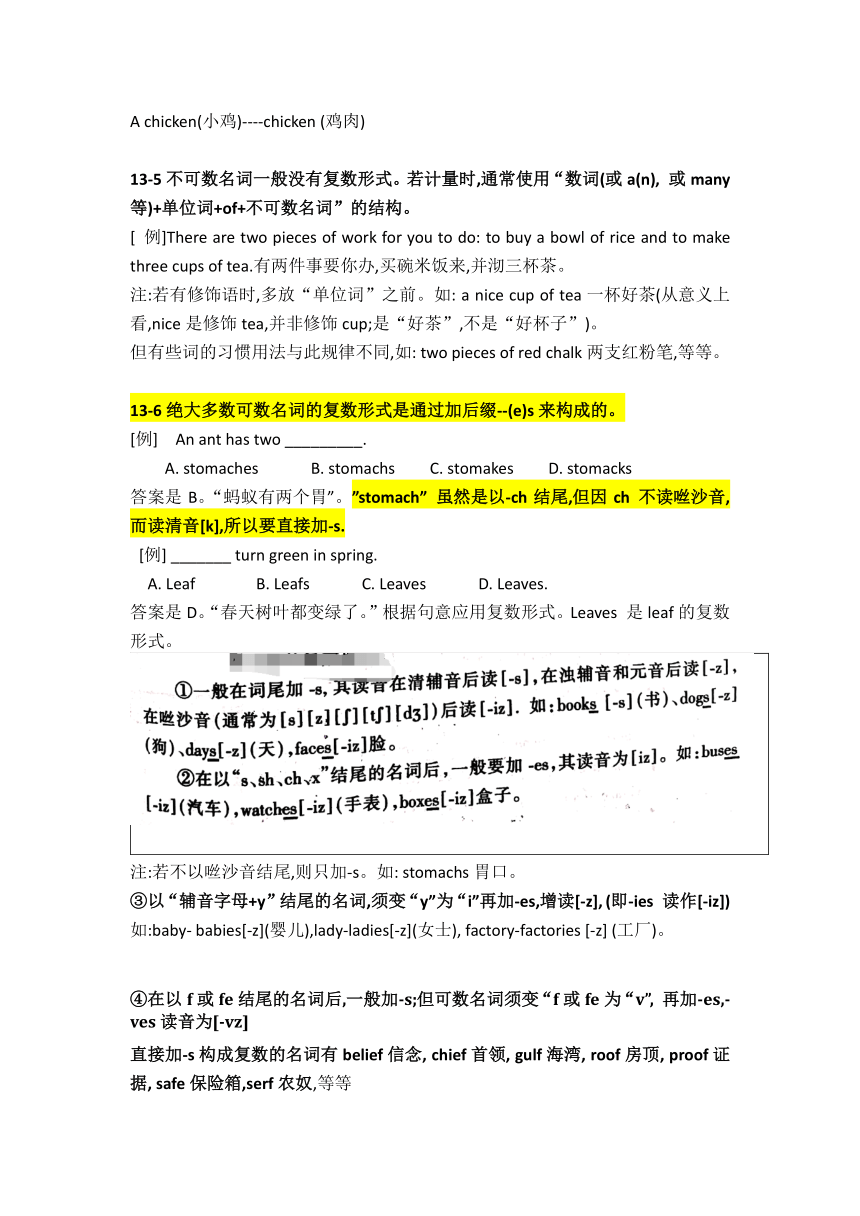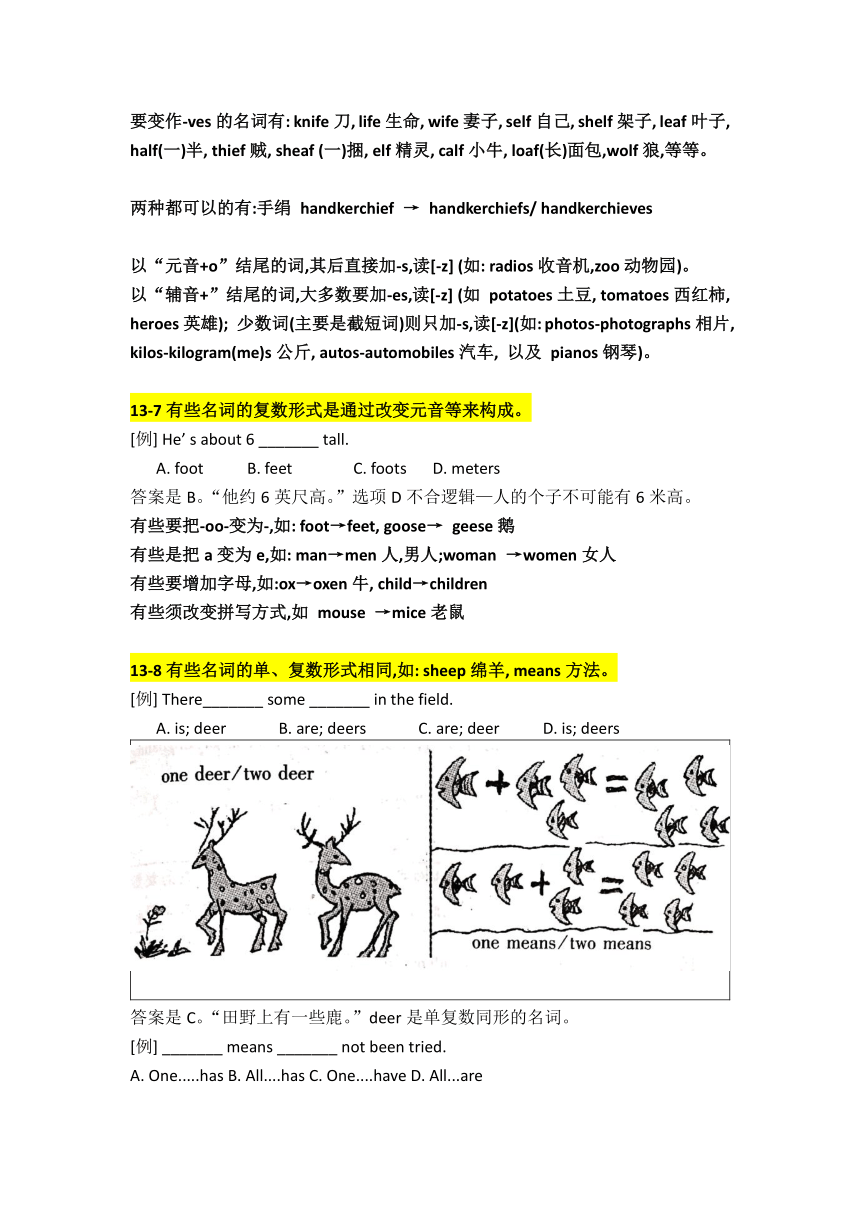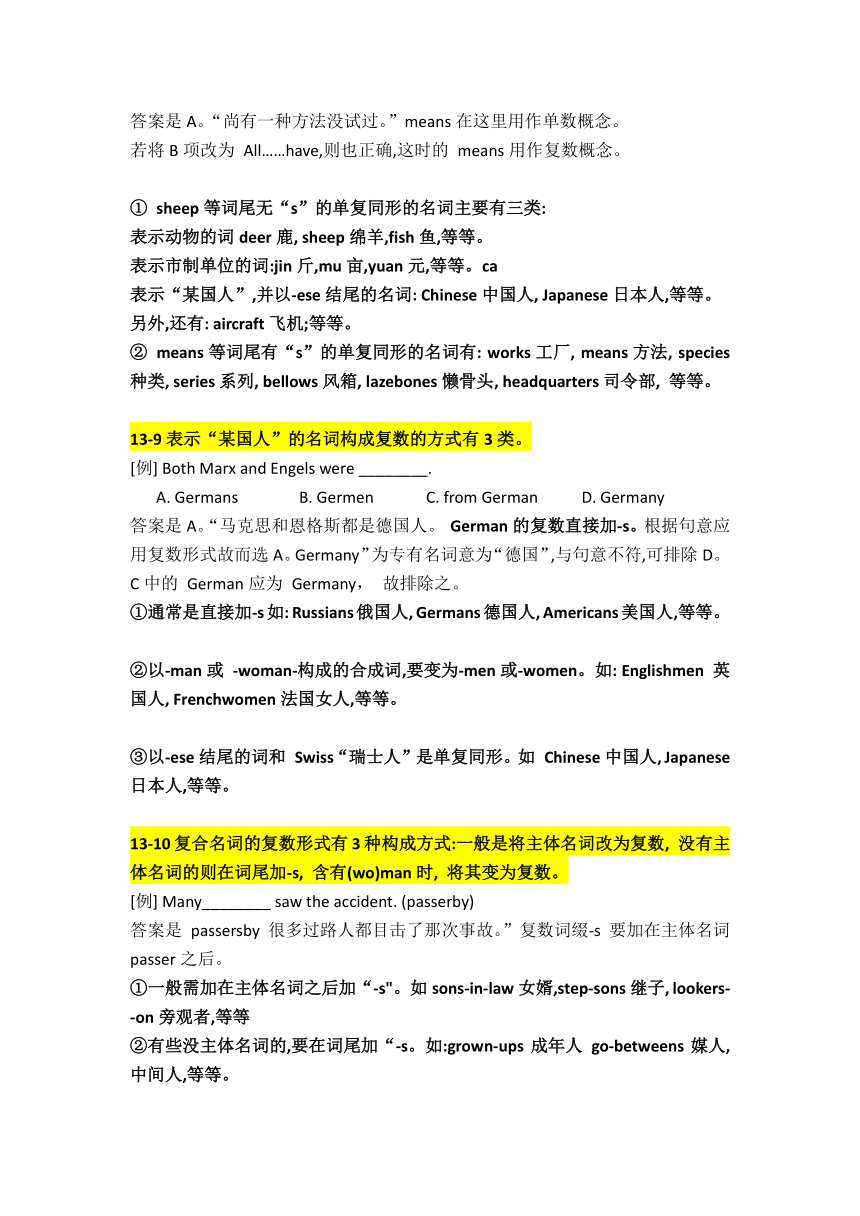名词(英语语法第13章)讲义(含答案)-2025届高三英语二轮复习专项
文档属性
| 名称 | 名词(英语语法第13章)讲义(含答案)-2025届高三英语二轮复习专项 |  | |
| 格式 | docx | ||
| 文件大小 | 1.3MB | ||
| 资源类型 | 教案 | ||
| 版本资源 | 人教版(2019) | ||
| 科目 | 英语 | ||
| 更新时间 | 2025-01-09 17:20:00 | ||
图片预览





文档简介
第13章名词
13-1名词是表示人、事物、地点或抽象概念的名称的词。有专有名词和普通名词之分;还有可数名词与不可数名词之分。
[例] If these trousers are too big, buy a smaller ________.
A. set B.one C. Beijing C. copy D. pair
答案是D。“假如这些裤子太长的话,买一条短点的。”pair是名词,意为“双”。习
惯上与 shoes、trousers等词搭配,这里指“一条短点的。”
名词的分类如下图所示:
13-2名词就词汇意义来说,可分为两大类普通名词和专有名词。普通名词是表示某一类人或物、某种物质或抽象概念的名称。专有名词是表示个人、国家、团体、地方、机构、组织等专有的名称。专有名词的第一个字母要大写。
[例] We are going to learn _______ next week.
A. Lesson Twelve B. Lesson Twelfth
C. Twelfth Lesson D. the lesson Twelfth
答案是A。“我们下周将学习第12课。”专有名词每个实词的第一个字母须大写,第十二课用 “Lesson Twelve” 或 “the Twelfth Lesson” 来表示。故选A。
13-3普通名词又可分为四种:个体名词、集体名词、物质名词和抽象名词。个体名词表示某类人或物中的个体(如: student学生)。集体名词表示若干个体组成的集合体(如: family家庭)。
物质名词表示无法分为个体的物质(如: water水)。抽象名词表示动作、状态、品质、感情等抽象概念(如:work工作、 beauty美)。
[例] Father went to his doctor for_____ about this heart trouble.
A. an advice B. advice C. advices D. the advices
答案是B。“父亲去看医生请教有关他的心脏病的事。advice”为抽象名词,抽象名词一般为不可数名词。故不能用不定冠词,不能用复数形式,故排除C、D.
[例] Tables are made of_____.
A. wood B. woods C. wooden D. some woods
答案是A。“桌子是由木头做的。wood为物质名词。不可数不用复数形式,可排除B, wooden是形容词,这里应选用名词,故排除C
13-4可数名词是指个体名词和集体名词, 它们可以用数目来计算,有单复数之分。不可数名词是指物质名词和抽象名词,它们一般无法用数目来计算。
[例] You should do more_____. Don't always sit at the desk busy doing Your_____.
A. exercise; exercises B. exercises; exercise
C. exercises; exercises D. exercise; exercise
答案是A。“你应该多做运动,不要老坐在桌旁忙着做练习。”exercise既能作可数名词(意为“练习”);又能作不可数名词意为“运动”、“锻炼”,根据句意选A
[例]he gained his_____ by printing_____ of famous writers.
A. wealth, work B. wealths, works
C. wealths, work D. wealth, works
答案是D。“他靠印刷名作家的作品获得财富。wealth为抽象不可数名词。work表示“工作”之意时为不可数名词;而 works表“作品、著作”之意时为可数名词。根据句意可排除A、B、C。
特别要注意这些特殊词:它们既可用作不可数名词、也可用作可数名词,但意义常有所不同。这是个难点,也是常考热点,应特别注意。
①物质名词表示种类或具体事物时,可成为可数名词。tea(茶)→teas(各种类);hair (头发)→ hair(一根头发); glass(玻)→ a glass(玻璃杯); paper(纸) →papers(试卷、论文、报纸)
②抽象名词的具体化使不可数名词成为可数名词。 beauty美→美人; diffculty困难,费力→难事; pleasure快乐→乐事; youth青春→青年.
③若可数名词用来表示抽象或物质意义时,就成为不可数名词。
A room(房间) -----room(空间)
A talk (报告) ----- talk (空谈)
A chicken(小鸡)----chicken (鸡肉)
13-5不可数名词一般没有复数形式。若计量时,通常使用“数词(或a(n), 或many等)+单位词+of+不可数名词”的结构。
[ 例]There are two pieces of work for you to do: to buy a bowl of rice and to make three cups of tea.有两件事要你办,买碗米饭来,并沏三杯茶。
注:若有修饰语时,多放“单位词”之前。如: a nice cup of tea一杯好茶(从意义上看,nice是修饰tea,并非修饰cup;是“好茶”,不是“好杯子”)。
但有些词的习惯用法与此规律不同,如: two pieces of red chalk两支红粉笔,等等。
13-6绝大多数可数名词的复数形式是通过加后缀--(e)s来构成的。
[例] An ant has two _________.
A. stomaches B. stomachs C. stomakes D. stomacks
答案是B。“蚂蚁有两个胃”。”stomach” 虽然是以-ch结尾,但因ch 不读咝沙音,而读清音[k],所以要直接加-s.
[例] _______ turn green in spring.
A. Leaf B. Leafs C. Leaves D. Leaves.
答案是D。“春天树叶都变绿了。”根据句意应用复数形式。Leaves 是leaf的复数形式。
注:若不以咝沙音结尾,则只加-s。如: stomachs胃口。
③以“辅音字母+y”结尾的名词,须变“y”为“i”再加-es,增读[-z], (即-ies 读作[-iz])如:baby- babies[-z](婴儿),lady-ladies[-z](女士), factory-factories [-z] (工厂)。
④在以f或fe结尾的名词后,一般加-s;但可数名词须变“f或fe为“v”, 再加-es,-ves读音为[-vz]
直接加-s构成复数的名词有belief信念, chief首领, gulf海湾, roof房顶, proof证据, safe保险箱,serf农奴,等等
要变作-ves的名词有: knife刀, life生命, wife妻子, self自己, shelf架子, leaf叶子, half(一)半, thief贼, sheaf (一)捆, elf精灵, calf小牛, loaf(长)面包,wolf狼,等等。
两种都可以的有:手绢 handkerchief → handkerchiefs/ handkerchieves
以“元音+o”结尾的词,其后直接加-s,读[-z] (如: radios收音机,zoo动物园)。
以“辅音+”结尾的词,大多数要加-es,读[-z] (如 potatoes土豆, tomatoes西红柿, heroes英雄); 少数词(主要是截短词)则只加-s,读[-z](如: photos-photographs相片, kilos-kilogram(me)s公斤, autos-automobiles汽车, 以及 pianos钢琴)。
13-7有些名词的复数形式是通过改变元音等来构成。
[例] He’ s about 6 _______ tall.
A. foot B. feet C. foots D. meters
答案是B。“他约6英尺高。”选项D不合逻辑—人的个子不可能有6米高。
有些要把-oo-变为-,如: foot→feet, goose→ geese鹅
有些是把a变为e,如: man→men人,男人;woman →women女人
有些要增加字母,如:ox→oxen牛, child→children
有些须改变拼写方式,如 mouse →mice老鼠
13-8有些名词的单、复数形式相同,如: sheep绵羊, means方法。
[例] There_______ some _______ in the field.
A. is; deer B. are; deers C. are; deer D. is; deers
答案是C。“田野上有一些鹿。”deer是单复数同形的名词。
[例] _______ means _______ not been tried.
A. One.....has B. All....has C. One....have D. All...are
答案是A。“尚有一种方法没试过。”means在这里用作单数概念。
若将B项改为 All……have,则也正确,这时的 means用作复数概念。
① sheep等词尾无“s”的单复同形的名词主要有三类:
表示动物的词deer鹿, sheep绵羊,fish鱼,等等。
表示市制单位的词:jin斤,mu亩,yuan元,等等。ca
表示“某国人”,并以-ese结尾的名词: Chinese中国人, Japanese日本人,等等。
另外,还有: aircraft飞机;等等。
② means等词尾有“s”的单复同形的名词有: works工厂, means方法, species种类, series系列, bellows风箱, lazebones懒骨头, headquarters司令部, 等等。
13-9表示“某国人”的名词构成复数的方式有3类。
[例] Both Marx and Engels were ________.
A. Germans B. Germen C. from German D. Germany
答案是A。“马克思和恩格斯都是德国人。 German的复数直接加-s。根据句意应用复数形式故而选A。Germany”为专有名词意为“德国”,与句意不符,可排除D。C中的 German应为 Germany, 故排除之。
①通常是直接加-s如: Russians俄国人, Germans德国人, Americans美国人,等等。
②以-man或 -woman-构成的合成词,要变为-men或-women。如: Englishmen 英国人, Frenchwomen法国女人,等等。
③以-ese结尾的词和 Swiss“瑞士人”是单复同形。如 Chinese中国人, Japanese日本人,等等。
13-10复合名词的复数形式有3种构成方式:一般是将主体名词改为复数, 没有主体名词的则在词尾加-s, 含有(wo)man时, 将其变为复数。
[例] Many________ saw the accident. (passerby)
答案是 passersby很多过路人都目击了那次事故。”复数词缀-s要加在主体名词 passer之后。
①一般需加在主体名词之后加“-s"。如sons-in-law女婿,step-sons继子, lookers--on旁观者,等等
②有些没主体名词的,要在词尾加“-s。如:grown-ups成年人 go-betweens媒人,中间人,等等。
③含有构词成分(wo)man的,要将其变为(wo)men. 如 newspapermen新闻记者, chairwomen女主席。
注:若是用独立的词(wo) man作另一个名词的定语,则(wo)man与被修饰名词均需变成复数。如:two men nurses两位男护理员, three women doctors 三位女医生,等等。
13-11名词单、复数的几种特殊表达方式。
[例] Shortly after the accident, two ______ police were sent. to the spot to keep order.
A. dozen of B. dozens C. dozen D. dozens of
答案是C。“事故刚发生不久,24名警察被派往现场维持秩序。 dozen与数词two连用表数量,用单数形式。
[例] Two ______ died of cold last winter.
A. hundreds old people B. hundred old people
C. hundreds old peoples D. hundred old peoples
答案是B。“去年冬天200名老年人死于寒冷。本句hundred之前有具体数字,应用其单数形式,故排除A、 C。 people为集合名词表复数概念,故排除D
①有些以-s结尾的名词,作“学科”解时往往作单数用。如: maths数学, physics物理,等等。
②有少数名词、形式上没有单数,但用作复数。如: police警察、 cattle牲畜, people人们,等等。
③有些名词和数词连用表示复数时,仍保持单数形式。如 two dozen eggs 两打鸡蛋, forty head of cattle 440头牲口,但是,果这些词的复数形式和介词of 的短语连用时,可表示“多”的概念。如: dozens of eggs几十个鸡蛋, hundreds of ducks数百只鸭子。
13-12名词有主格、宾格和所有格形式。主格作主语,宾格作宾语,主格与
宾格形式上没有区别。所有格多作定语(有时作表语)表示人或物的隶属关系。
[例] _________ car broke down on the way,, but luckily they knew how to fix it.
A. Tom's and Jane's B. Tom's and Jane
C. Tom and Jane's D. Tom and Jane
答案是C。“汤姆和珍的车在路上坏了,但幸运的是他们知道如何修理。”名词car作主语,是主格形式;名词way作介词on的宾语, 是宾格形式。空格处作定语,表示“某人的”,要用所有格形式,排除D。从被修饰词“car”为单数可看出是“汤姆和珍共有的”,只能在最后一个名词上加所属格符号,故选C。而A项表示“汤姆和珍各自所拥有的”,要与复数cars连用才合理。
13-13“名词+ s的所有格形式主要用于表示有生命名词的所属关系, 也可用于表时间、距离、城镇、国家等表示无生命事物的名词。
[例] ---I wonder whose bicycle it is.
---- It might be my ______.
A. neighbour's B. dear neighbour
C. neighbour D. neighbours
答案是A。“我想知道这是谁的自行车。“大概是我邻居的吧。”根据 句意“我邻居的(自行车)”,显然和所修饰的名词 bicycle (名省略 了)有逻辑上所属关系;故选’s结构。因为 bicycle被省略,这时的所有格“neighbour's作表语。
[例]“Where is your brother ”
“At_________.”
A. Mr. Green's B. Mr. Green
C. the Mr. Green's D. the Mr. Green
答案是A。“你兄弟在哪儿 “在格林先生家。”相当于 ”At Mr Green's house".
注:表示“家”、“店铺”、“办公室”等处所时,由“名词+ ’s”所有格所修饰的名词 house, shop, office常被省略。又如:at the tailor's (shop)在服装店, at the doctor's (office) 在医生的诊疗所里。
13-14“名词+ ’s所有格的构成方法,有两种:-s’和 –’;其读音规则类似于名词复数词尾-(e)s的读音规则。
13-15 “of+名词”的所有格形式主要用于表示无生命名词的所属关系(有时也表示一种逻辑上的主谓关系、动宾关系或同位关系);有时也可用于表示有生命名词的所属关系(尤其是当名词较长时)。
[例] 改错: People in different parts in the world learn to understand one another.
答案是把“in the world改为“of the world”。“世界各地的人们学会了彼此互相理解。”此处是表所属关系,要用“of。
[例] I only know the girl's' name. I don 't' know______standing by the door.
A. the boy's name B. the name of the boy
C. the name of the boy's D. the name of the boys
答案是B。“我只知道那女孩的名字。我不知道站在门口的那男孩的名字。”“boy”虽与“girl”同为表示有生命事物的名词,但因其后跟有长长的定语 standing by the door,使得整个名词短语太长了,故不用’s形式,而用of形式。所给A项放入句中的话,“站在门口的”则成了“name,"而不是boy”,逻辑上不合理。
13-16 “of+名词的’s所有格”或“of+名词性物主代词”称为双重所有格。常表“部分”概念(被修饰名词前通常有表示数量的词a, two, many等) 或感彩(被修饰名词前通常有指示代词 this, that, these, those等)。
[例] Miss Smith is a friend of _________.
A. Mary's mother's B. Mary's mother
C. Mother's of Mary D. Marys Mother's
答案是A。“史密斯小姐是玛丽母亲的一位朋友。”根据题意,应用名词双重所有格表达“部分”概念,即“玛丽母亲的朋友中的一个朋友”。
[例] Look at this lovely daughter of my teacher’s.“你看我们老师的这个可爱的女儿。”
13-17名词在句中可充当除谓语动词以外的各种成分(主、宾、表、定、状、补、同位语及独立成分)。
[例] The ______ of the cottage were covered with _________.
A. roofs, leafs B. roofs, leaves
C. rooves, leafs D. rooves, leaves
答案是B。“这间村舍的屋宾表状顶盖满了树叶。”名词“roofs”(是roof的复数)作主语。”leaves”(是leaf的复数)作介词宾语。名词 cottage作介词of 的宾语。
[例] He dropped the________ and broke it
A. cup of coffee B. coffee's cup
C. cup for coffee D. coffee cup
答案是D。“他失手掉了咖啡杯,并且打碎了。A意为“这杯咖啡与后半句“打碎了”句意不符; B用了名词所有格形式 coffe's 表示杯子cup是属于coffee的,不合适;D coffee中为名词作定语 修饰cup,表示cup的用途。
注:名词作定语时一般用单数形式,如: two apple trees,两棵苹果树; two shoe shops两家鞋店, many bus drivers许多汽车司机,等等。但如作定语的名词,是(wo) man时,则定语与被修饰名词要单复数一致,如 three men (或women doctors三位男(或女)博士学.
[例] He is a students of ________ .
A. Class First B. the Class One
C. Class One D. First Class
答案是C。“他是一班的一个学生。”专有名词“Class One” 作介词的宾语;普通名词 student作表语。
[例] But I can't' give these orders, unless you can wait _______.
A. some time B. sometimes C. for sometime D. sometime
答案是A。“但我现在还不能订购这些,除非你能等些时候。”B 为“有时”,不合题意;C、D中的 sometime表示“某时”与句意不符; A表“一段时间”为正确选择, some time是名词短语作时间状语; 名词 orders是作动词give的宾语。
第13章“名词”专项能力训练题
1.单项填空:
1. Here is my card. Let's keep in ________.
A. touch B. relation C. connect D. friend
2. I'll look into the matter as soon as possible. Just have a little ________.
A. wait B. time C. patience D. rest
3. How beautifully she sings! I have never heard ________.
A. the best voice B. a good voice
C. the better voice D. a better voice
4. The children are playing on the ________ of the beach.
A. sand B. sands C. sander D. sandy
5. _______will make a trip around the world during the coming Christmas.
A. The Evens B. The Evens'
C. The Evenses D. The Evenes'
6. Let's stop by the ________ on the way there.
A. books store B. book's store C. book store D. store of books
7. ----I'd like ________ information about the management of your hotel, please.
----Well, you could have ________ word with the manager. He might be helpful.
A. some, a B. an, some C. some, some D. an, e
8. The number of people invited ______ fifty but a number of them ________absent for different reason.
A. were, was B. was, was C. was, were D. were, were
9. They are ______ of different presses. Now they are having a meeting in one of the ______ office.
A. editor-in-chiefs, editors-in-chief's
B. editors-in-chief, editor-in-chief's
C. editors-in-chiefs, editor’s-in-chief's
D. editors-in-chief, editors-in-chief's
10. What a lot of ________ I have to finish today!
A. works B. work C. job D. workings
Ⅱ改错
1. We stopped to rest for a while and to drink some waters from a stream.
2. Modern people know more about the health, have better food and live in cleaner surroundings.
3. We have been to Europe many time.
4. There are branch library in many villages.
5. I hope that you two could come and visit us some times soon.
6. They were eager to know everything about China and also asked me lots of question.
7. A journey of a thousand mile must begin with a single step.
8. He has lost a lot of weights in the past few years.
9. The tree was bursting leaf, fresh and green and lovely.
10. Parents should help their children to form good habit.
13-1名词是表示人、事物、地点或抽象概念的名称的词。有专有名词和普通名词之分;还有可数名词与不可数名词之分。
[例] If these trousers are too big, buy a smaller ________.
A. set B.one C. Beijing C. copy D. pair
答案是D。“假如这些裤子太长的话,买一条短点的。”pair是名词,意为“双”。习
惯上与 shoes、trousers等词搭配,这里指“一条短点的。”
名词的分类如下图所示:
13-2名词就词汇意义来说,可分为两大类普通名词和专有名词。普通名词是表示某一类人或物、某种物质或抽象概念的名称。专有名词是表示个人、国家、团体、地方、机构、组织等专有的名称。专有名词的第一个字母要大写。
[例] We are going to learn _______ next week.
A. Lesson Twelve B. Lesson Twelfth
C. Twelfth Lesson D. the lesson Twelfth
答案是A。“我们下周将学习第12课。”专有名词每个实词的第一个字母须大写,第十二课用 “Lesson Twelve” 或 “the Twelfth Lesson” 来表示。故选A。
13-3普通名词又可分为四种:个体名词、集体名词、物质名词和抽象名词。个体名词表示某类人或物中的个体(如: student学生)。集体名词表示若干个体组成的集合体(如: family家庭)。
物质名词表示无法分为个体的物质(如: water水)。抽象名词表示动作、状态、品质、感情等抽象概念(如:work工作、 beauty美)。
[例] Father went to his doctor for_____ about this heart trouble.
A. an advice B. advice C. advices D. the advices
答案是B。“父亲去看医生请教有关他的心脏病的事。advice”为抽象名词,抽象名词一般为不可数名词。故不能用不定冠词,不能用复数形式,故排除C、D.
[例] Tables are made of_____.
A. wood B. woods C. wooden D. some woods
答案是A。“桌子是由木头做的。wood为物质名词。不可数不用复数形式,可排除B, wooden是形容词,这里应选用名词,故排除C
13-4可数名词是指个体名词和集体名词, 它们可以用数目来计算,有单复数之分。不可数名词是指物质名词和抽象名词,它们一般无法用数目来计算。
[例] You should do more_____. Don't always sit at the desk busy doing Your_____.
A. exercise; exercises B. exercises; exercise
C. exercises; exercises D. exercise; exercise
答案是A。“你应该多做运动,不要老坐在桌旁忙着做练习。”exercise既能作可数名词(意为“练习”);又能作不可数名词意为“运动”、“锻炼”,根据句意选A
[例]he gained his_____ by printing_____ of famous writers.
A. wealth, work B. wealths, works
C. wealths, work D. wealth, works
答案是D。“他靠印刷名作家的作品获得财富。wealth为抽象不可数名词。work表示“工作”之意时为不可数名词;而 works表“作品、著作”之意时为可数名词。根据句意可排除A、B、C。
特别要注意这些特殊词:它们既可用作不可数名词、也可用作可数名词,但意义常有所不同。这是个难点,也是常考热点,应特别注意。
①物质名词表示种类或具体事物时,可成为可数名词。tea(茶)→teas(各种类);hair (头发)→ hair(一根头发); glass(玻)→ a glass(玻璃杯); paper(纸) →papers(试卷、论文、报纸)
②抽象名词的具体化使不可数名词成为可数名词。 beauty美→美人; diffculty困难,费力→难事; pleasure快乐→乐事; youth青春→青年.
③若可数名词用来表示抽象或物质意义时,就成为不可数名词。
A room(房间) -----room(空间)
A talk (报告) ----- talk (空谈)
A chicken(小鸡)----chicken (鸡肉)
13-5不可数名词一般没有复数形式。若计量时,通常使用“数词(或a(n), 或many等)+单位词+of+不可数名词”的结构。
[ 例]There are two pieces of work for you to do: to buy a bowl of rice and to make three cups of tea.有两件事要你办,买碗米饭来,并沏三杯茶。
注:若有修饰语时,多放“单位词”之前。如: a nice cup of tea一杯好茶(从意义上看,nice是修饰tea,并非修饰cup;是“好茶”,不是“好杯子”)。
但有些词的习惯用法与此规律不同,如: two pieces of red chalk两支红粉笔,等等。
13-6绝大多数可数名词的复数形式是通过加后缀--(e)s来构成的。
[例] An ant has two _________.
A. stomaches B. stomachs C. stomakes D. stomacks
答案是B。“蚂蚁有两个胃”。”stomach” 虽然是以-ch结尾,但因ch 不读咝沙音,而读清音[k],所以要直接加-s.
[例] _______ turn green in spring.
A. Leaf B. Leafs C. Leaves D. Leaves.
答案是D。“春天树叶都变绿了。”根据句意应用复数形式。Leaves 是leaf的复数形式。
注:若不以咝沙音结尾,则只加-s。如: stomachs胃口。
③以“辅音字母+y”结尾的名词,须变“y”为“i”再加-es,增读[-z], (即-ies 读作[-iz])如:baby- babies[-z](婴儿),lady-ladies[-z](女士), factory-factories [-z] (工厂)。
④在以f或fe结尾的名词后,一般加-s;但可数名词须变“f或fe为“v”, 再加-es,-ves读音为[-vz]
直接加-s构成复数的名词有belief信念, chief首领, gulf海湾, roof房顶, proof证据, safe保险箱,serf农奴,等等
要变作-ves的名词有: knife刀, life生命, wife妻子, self自己, shelf架子, leaf叶子, half(一)半, thief贼, sheaf (一)捆, elf精灵, calf小牛, loaf(长)面包,wolf狼,等等。
两种都可以的有:手绢 handkerchief → handkerchiefs/ handkerchieves
以“元音+o”结尾的词,其后直接加-s,读[-z] (如: radios收音机,zoo动物园)。
以“辅音+”结尾的词,大多数要加-es,读[-z] (如 potatoes土豆, tomatoes西红柿, heroes英雄); 少数词(主要是截短词)则只加-s,读[-z](如: photos-photographs相片, kilos-kilogram(me)s公斤, autos-automobiles汽车, 以及 pianos钢琴)。
13-7有些名词的复数形式是通过改变元音等来构成。
[例] He’ s about 6 _______ tall.
A. foot B. feet C. foots D. meters
答案是B。“他约6英尺高。”选项D不合逻辑—人的个子不可能有6米高。
有些要把-oo-变为-,如: foot→feet, goose→ geese鹅
有些是把a变为e,如: man→men人,男人;woman →women女人
有些要增加字母,如:ox→oxen牛, child→children
有些须改变拼写方式,如 mouse →mice老鼠
13-8有些名词的单、复数形式相同,如: sheep绵羊, means方法。
[例] There_______ some _______ in the field.
A. is; deer B. are; deers C. are; deer D. is; deers
答案是C。“田野上有一些鹿。”deer是单复数同形的名词。
[例] _______ means _______ not been tried.
A. One.....has B. All....has C. One....have D. All...are
答案是A。“尚有一种方法没试过。”means在这里用作单数概念。
若将B项改为 All……have,则也正确,这时的 means用作复数概念。
① sheep等词尾无“s”的单复同形的名词主要有三类:
表示动物的词deer鹿, sheep绵羊,fish鱼,等等。
表示市制单位的词:jin斤,mu亩,yuan元,等等。ca
表示“某国人”,并以-ese结尾的名词: Chinese中国人, Japanese日本人,等等。
另外,还有: aircraft飞机;等等。
② means等词尾有“s”的单复同形的名词有: works工厂, means方法, species种类, series系列, bellows风箱, lazebones懒骨头, headquarters司令部, 等等。
13-9表示“某国人”的名词构成复数的方式有3类。
[例] Both Marx and Engels were ________.
A. Germans B. Germen C. from German D. Germany
答案是A。“马克思和恩格斯都是德国人。 German的复数直接加-s。根据句意应用复数形式故而选A。Germany”为专有名词意为“德国”,与句意不符,可排除D。C中的 German应为 Germany, 故排除之。
①通常是直接加-s如: Russians俄国人, Germans德国人, Americans美国人,等等。
②以-man或 -woman-构成的合成词,要变为-men或-women。如: Englishmen 英国人, Frenchwomen法国女人,等等。
③以-ese结尾的词和 Swiss“瑞士人”是单复同形。如 Chinese中国人, Japanese日本人,等等。
13-10复合名词的复数形式有3种构成方式:一般是将主体名词改为复数, 没有主体名词的则在词尾加-s, 含有(wo)man时, 将其变为复数。
[例] Many________ saw the accident. (passerby)
答案是 passersby很多过路人都目击了那次事故。”复数词缀-s要加在主体名词 passer之后。
①一般需加在主体名词之后加“-s"。如sons-in-law女婿,step-sons继子, lookers--on旁观者,等等
②有些没主体名词的,要在词尾加“-s。如:grown-ups成年人 go-betweens媒人,中间人,等等。
③含有构词成分(wo)man的,要将其变为(wo)men. 如 newspapermen新闻记者, chairwomen女主席。
注:若是用独立的词(wo) man作另一个名词的定语,则(wo)man与被修饰名词均需变成复数。如:two men nurses两位男护理员, three women doctors 三位女医生,等等。
13-11名词单、复数的几种特殊表达方式。
[例] Shortly after the accident, two ______ police were sent. to the spot to keep order.
A. dozen of B. dozens C. dozen D. dozens of
答案是C。“事故刚发生不久,24名警察被派往现场维持秩序。 dozen与数词two连用表数量,用单数形式。
[例] Two ______ died of cold last winter.
A. hundreds old people B. hundred old people
C. hundreds old peoples D. hundred old peoples
答案是B。“去年冬天200名老年人死于寒冷。本句hundred之前有具体数字,应用其单数形式,故排除A、 C。 people为集合名词表复数概念,故排除D
①有些以-s结尾的名词,作“学科”解时往往作单数用。如: maths数学, physics物理,等等。
②有少数名词、形式上没有单数,但用作复数。如: police警察、 cattle牲畜, people人们,等等。
③有些名词和数词连用表示复数时,仍保持单数形式。如 two dozen eggs 两打鸡蛋, forty head of cattle 440头牲口,但是,果这些词的复数形式和介词of 的短语连用时,可表示“多”的概念。如: dozens of eggs几十个鸡蛋, hundreds of ducks数百只鸭子。
13-12名词有主格、宾格和所有格形式。主格作主语,宾格作宾语,主格与
宾格形式上没有区别。所有格多作定语(有时作表语)表示人或物的隶属关系。
[例] _________ car broke down on the way,, but luckily they knew how to fix it.
A. Tom's and Jane's B. Tom's and Jane
C. Tom and Jane's D. Tom and Jane
答案是C。“汤姆和珍的车在路上坏了,但幸运的是他们知道如何修理。”名词car作主语,是主格形式;名词way作介词on的宾语, 是宾格形式。空格处作定语,表示“某人的”,要用所有格形式,排除D。从被修饰词“car”为单数可看出是“汤姆和珍共有的”,只能在最后一个名词上加所属格符号,故选C。而A项表示“汤姆和珍各自所拥有的”,要与复数cars连用才合理。
13-13“名词+ s的所有格形式主要用于表示有生命名词的所属关系, 也可用于表时间、距离、城镇、国家等表示无生命事物的名词。
[例] ---I wonder whose bicycle it is.
---- It might be my ______.
A. neighbour's B. dear neighbour
C. neighbour D. neighbours
答案是A。“我想知道这是谁的自行车。“大概是我邻居的吧。”根据 句意“我邻居的(自行车)”,显然和所修饰的名词 bicycle (名省略 了)有逻辑上所属关系;故选’s结构。因为 bicycle被省略,这时的所有格“neighbour's作表语。
[例]“Where is your brother ”
“At_________.”
A. Mr. Green's B. Mr. Green
C. the Mr. Green's D. the Mr. Green
答案是A。“你兄弟在哪儿 “在格林先生家。”相当于 ”At Mr Green's house".
注:表示“家”、“店铺”、“办公室”等处所时,由“名词+ ’s”所有格所修饰的名词 house, shop, office常被省略。又如:at the tailor's (shop)在服装店, at the doctor's (office) 在医生的诊疗所里。
13-14“名词+ ’s所有格的构成方法,有两种:-s’和 –’;其读音规则类似于名词复数词尾-(e)s的读音规则。
13-15 “of+名词”的所有格形式主要用于表示无生命名词的所属关系(有时也表示一种逻辑上的主谓关系、动宾关系或同位关系);有时也可用于表示有生命名词的所属关系(尤其是当名词较长时)。
[例] 改错: People in different parts in the world learn to understand one another.
答案是把“in the world改为“of the world”。“世界各地的人们学会了彼此互相理解。”此处是表所属关系,要用“of。
[例] I only know the girl's' name. I don 't' know______standing by the door.
A. the boy's name B. the name of the boy
C. the name of the boy's D. the name of the boys
答案是B。“我只知道那女孩的名字。我不知道站在门口的那男孩的名字。”“boy”虽与“girl”同为表示有生命事物的名词,但因其后跟有长长的定语 standing by the door,使得整个名词短语太长了,故不用’s形式,而用of形式。所给A项放入句中的话,“站在门口的”则成了“name,"而不是boy”,逻辑上不合理。
13-16 “of+名词的’s所有格”或“of+名词性物主代词”称为双重所有格。常表“部分”概念(被修饰名词前通常有表示数量的词a, two, many等) 或感彩(被修饰名词前通常有指示代词 this, that, these, those等)。
[例] Miss Smith is a friend of _________.
A. Mary's mother's B. Mary's mother
C. Mother's of Mary D. Marys Mother's
答案是A。“史密斯小姐是玛丽母亲的一位朋友。”根据题意,应用名词双重所有格表达“部分”概念,即“玛丽母亲的朋友中的一个朋友”。
[例] Look at this lovely daughter of my teacher’s.“你看我们老师的这个可爱的女儿。”
13-17名词在句中可充当除谓语动词以外的各种成分(主、宾、表、定、状、补、同位语及独立成分)。
[例] The ______ of the cottage were covered with _________.
A. roofs, leafs B. roofs, leaves
C. rooves, leafs D. rooves, leaves
答案是B。“这间村舍的屋宾表状顶盖满了树叶。”名词“roofs”(是roof的复数)作主语。”leaves”(是leaf的复数)作介词宾语。名词 cottage作介词of 的宾语。
[例] He dropped the________ and broke it
A. cup of coffee B. coffee's cup
C. cup for coffee D. coffee cup
答案是D。“他失手掉了咖啡杯,并且打碎了。A意为“这杯咖啡与后半句“打碎了”句意不符; B用了名词所有格形式 coffe's 表示杯子cup是属于coffee的,不合适;D coffee中为名词作定语 修饰cup,表示cup的用途。
注:名词作定语时一般用单数形式,如: two apple trees,两棵苹果树; two shoe shops两家鞋店, many bus drivers许多汽车司机,等等。但如作定语的名词,是(wo) man时,则定语与被修饰名词要单复数一致,如 three men (或women doctors三位男(或女)博士学.
[例] He is a students of ________ .
A. Class First B. the Class One
C. Class One D. First Class
答案是C。“他是一班的一个学生。”专有名词“Class One” 作介词的宾语;普通名词 student作表语。
[例] But I can't' give these orders, unless you can wait _______.
A. some time B. sometimes C. for sometime D. sometime
答案是A。“但我现在还不能订购这些,除非你能等些时候。”B 为“有时”,不合题意;C、D中的 sometime表示“某时”与句意不符; A表“一段时间”为正确选择, some time是名词短语作时间状语; 名词 orders是作动词give的宾语。
第13章“名词”专项能力训练题
1.单项填空:
1. Here is my card. Let's keep in ________.
A. touch B. relation C. connect D. friend
2. I'll look into the matter as soon as possible. Just have a little ________.
A. wait B. time C. patience D. rest
3. How beautifully she sings! I have never heard ________.
A. the best voice B. a good voice
C. the better voice D. a better voice
4. The children are playing on the ________ of the beach.
A. sand B. sands C. sander D. sandy
5. _______will make a trip around the world during the coming Christmas.
A. The Evens B. The Evens'
C. The Evenses D. The Evenes'
6. Let's stop by the ________ on the way there.
A. books store B. book's store C. book store D. store of books
7. ----I'd like ________ information about the management of your hotel, please.
----Well, you could have ________ word with the manager. He might be helpful.
A. some, a B. an, some C. some, some D. an, e
8. The number of people invited ______ fifty but a number of them ________absent for different reason.
A. were, was B. was, was C. was, were D. were, were
9. They are ______ of different presses. Now they are having a meeting in one of the ______ office.
A. editor-in-chiefs, editors-in-chief's
B. editors-in-chief, editor-in-chief's
C. editors-in-chiefs, editor’s-in-chief's
D. editors-in-chief, editors-in-chief's
10. What a lot of ________ I have to finish today!
A. works B. work C. job D. workings
Ⅱ改错
1. We stopped to rest for a while and to drink some waters from a stream.
2. Modern people know more about the health, have better food and live in cleaner surroundings.
3. We have been to Europe many time.
4. There are branch library in many villages.
5. I hope that you two could come and visit us some times soon.
6. They were eager to know everything about China and also asked me lots of question.
7. A journey of a thousand mile must begin with a single step.
8. He has lost a lot of weights in the past few years.
9. The tree was bursting leaf, fresh and green and lovely.
10. Parents should help their children to form good habit.
